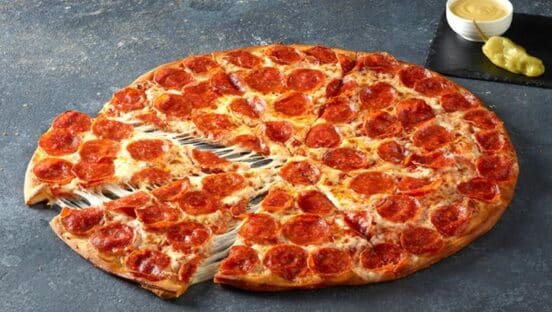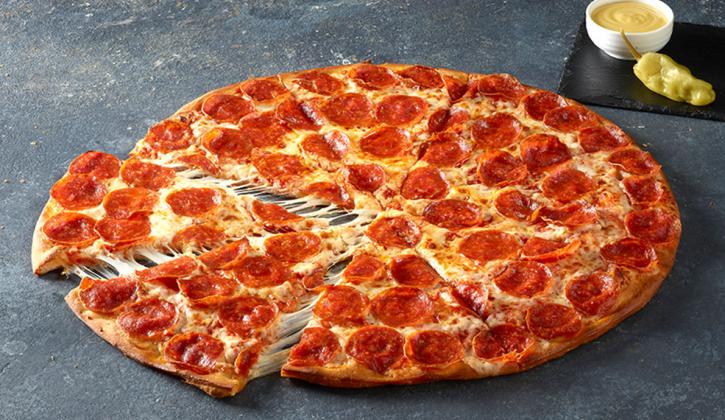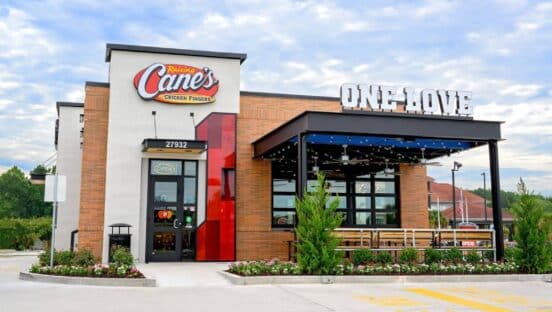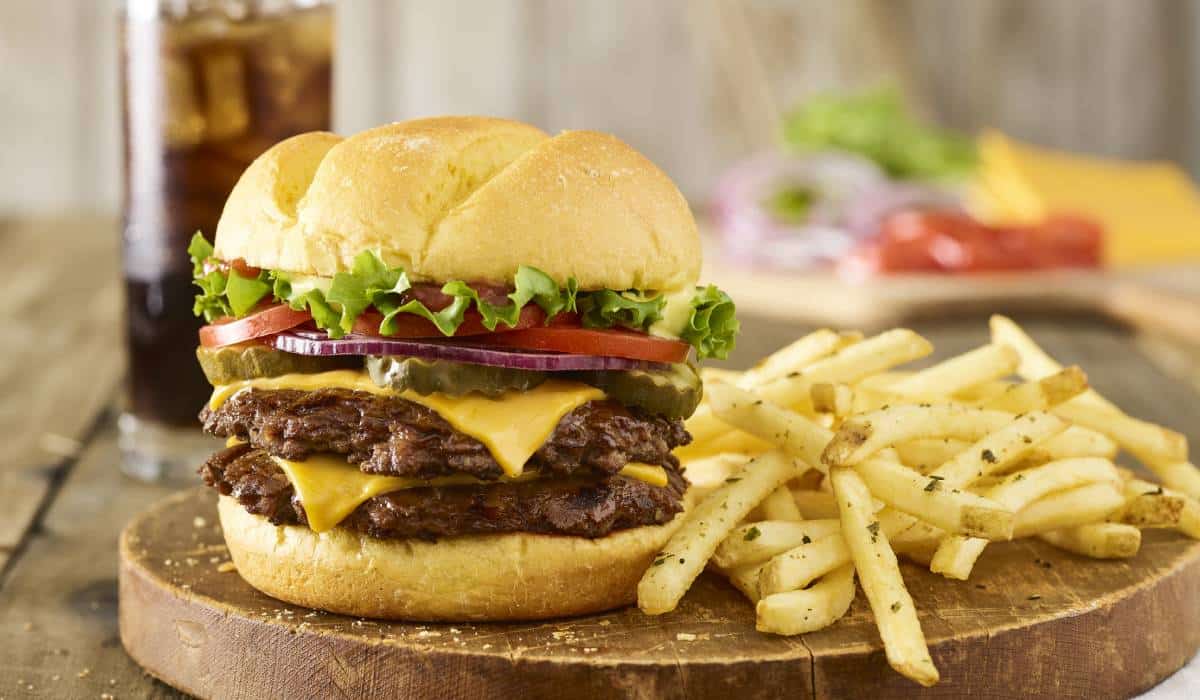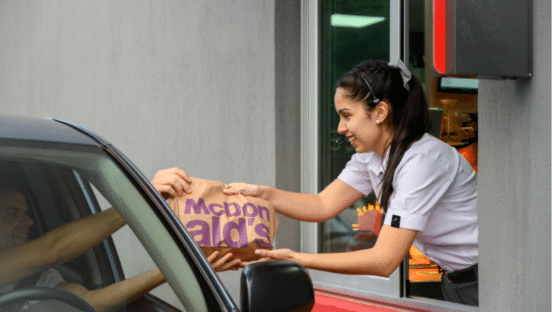Rob Lynch was attending a meeting during his first week at Papa John’s. On the table was a proposal for a significant value program—an alien notion for the pizza chain if there ever was one. But there was also zero delusion about how dire Papa John’s standing had become.
An ugly, years-long back-and-forth with founder John Schnatter warped Papa John’s public image. Sales dropped 12 percent in fiscal 2018, which marked the first annual decline in nine years. In North America, 128 locations shuttered in 2018 versus 79 opens. A year earlier, 186 franchises closed, along with seven corporate stores. At one point, same-store sales reported negative for seven consecutive quarters (Q4 2017 to Q2 2019).
So Papa John’s playbook felt tenuous at best. Why not shake it up? Papa John’s tested a $6 platform in several markets across 2019, consisting of a medium one-topping pizza, sandwiches, wings, breadsticks, and desserts. The initial thought was to pilot the structure and potentially other platforms throughout the second half of the year, with a possible national launch in 2020.
Lynch, however, had seen this story before. When he served as president of 3,400-unit Arby’s, the chain transformed into a “Fast-Crafted” brand and posted 16 straight periods of comps growth, reaching record sales and profits in 2018.
Arby’s needed to understand one thing before it could get there, Lynch says. “I told everyone, I said, we cannot beat McDonald’s by trying to be McDonald’s.”
His message to Papa John’s rang familiar. “I’ll never forget sitting in that meeting and asking the team if they thought they could beat Domino’s by trying to be Domino’s.”
“We have to be what is special, unique, interesting, and differentiating about Papa John’s,” says Lynch, who was officially announced as CEO in August 2019.
Lynch scrapped value and asked a different question of his new colleagues—do we have anything cooking in the innovation tank?
Let’s fast-forward briefly to the edge of 2021. Trying to reimagine that moment with hindsight brings a laugh out of Lynch. What would have happened if he told the room Papa John’s would launch six new products in 2020 alone, right in the heart of a global pandemic?
“I think it would have been the response I’m having to your question,” Lynch says, still laughing.
THE COVID-19 ROAD FOR PAPA JOHN’S SO FAR
Papa John’s to Provide $2.5 Million in Bonuses for Front-Line Employees
Former Target Exec Joins Papa John’s as Chief Financial Officer
Papa John’s to Open New Global Headquarters in Atlanta
Papa John’s Signs Largest North America Development Deal in 20 Years
Papa John’s Red-Hot Run Continues
Papa John’s to Hire 10,000 More Employees Over Coming Months
At Papa John’s, the Comeback is Just Beginning
Papa John’s Introduces the Extra Large Shaq-a-Roni Pizza
Papa John’s Continues to Reach Unprecedented Sales
Better Culture, Better Plan, Better Papa John’s?
Papa John’s Sees Highest Sales Month in Company’s History
There are lot of words to describe what’s taken shape at Papa John’s over the past 12, COVID-19 riddled months. Yet none weigh as heavy as “innovation.” And to say it’s paid off in 2020 would be a comical understatement in a year full of them.
In Q3, North American stores reported same-store sales growth of 23.8 percent. Domestic company venues soared 18.2 percent, North American franchises 25.5 percent, and international units 20.6 percent.
As you can see below, Papa John’s dramatic downturn is long gone, replaced instead by record-setting figures:
Same-store sales trends (North America)
- Q2 2016: 4.8 percent
- Q3 2016: 5.5 percent
- Q4 2016: 3.8 percent
- Q1 2017: 2 percent
- Q2 2017: 1.4 percent
- Q3 2017: 1 percent
- Q4 2017: -3.9 percent
- Q1 2018: -5.3 percent
- Q2 2018: –6.1 percent
- Q3 2018: –9.8 percent
- Q4 2018: –8.1 percent
- Q1 2019: –6.9 percent
- Q2 2019: –5.7 percent
- Q3 2019: 1 percent
- Q4 2019: 3.5 percent
- Q1 2020: 5.3 percent
- Q2 2020: 28 percent
- Q3 2020: 23.8 percent
What did Papa John’s leaders say when Lynch decided to toss value aside in favor of product innovation at a company not known for it? “They were like, ‘what do you mean?’” Lynch says.
While Papa John’s shed its founder’s image from marketing materials and company communications in recent years, there remained wariness with how to balance the past and yet still push forward. Papa John’s had to reposition and reenergize itself, but it had to do so by delivering on the core of the brand—Better Ingredients, Better Pizza. The chain surged to 5,347 locations (3,284 North America) on the balance of being a premium player in the quick-service pizza space. Things like garlic dipping sauce and the pepperoncinis guests expect in each box.
“It was in that meeting, in that first week, where we made a strategic decision that we were going to get back to what had originally made the brand great,” Lynch says.
Management told Lynch they piloted a garlic parmesan crust, “but we’re not allowed to change crusts.”
“And I said, ‘says who?” Lynch recalls. “They were like, ‘you know who.’”
Lynch’s response, though, wasn’t to nod and move on. He asked how fast could Papa John’s bring it to market. A couple of months? Let’s plan on it.
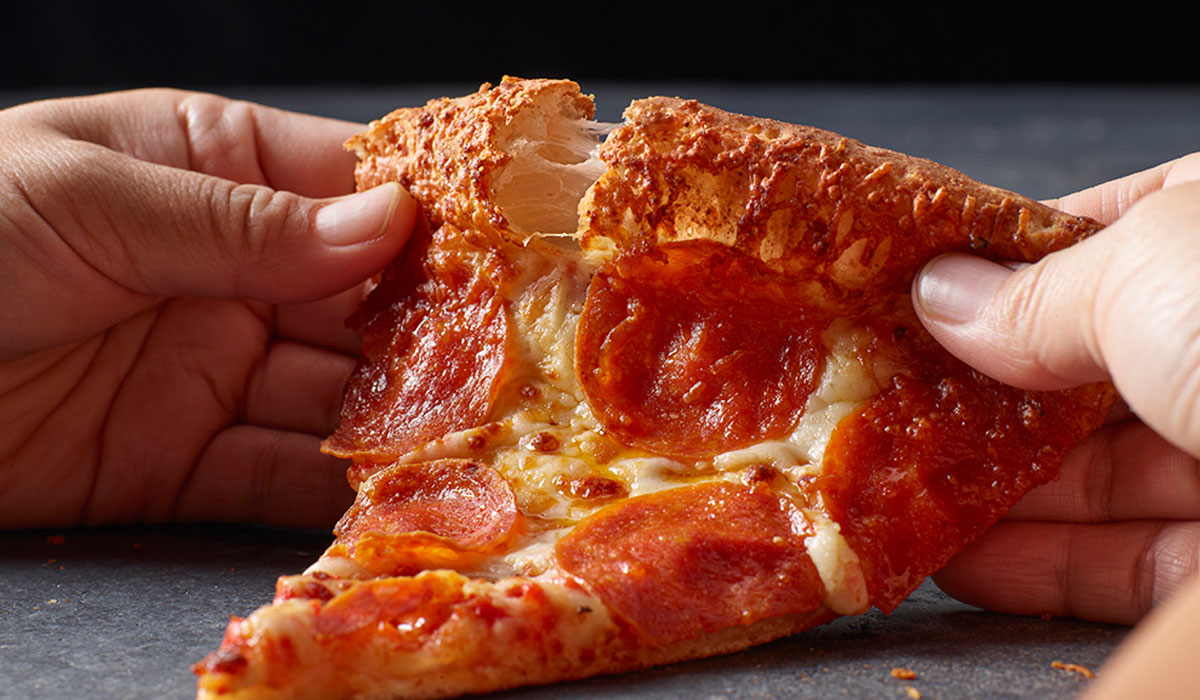
Garlic Parmesan Crust marked the first time Papa John’s added to its six-ingredient, fresh, never-frozen original pizza dough in company history.
Papa John’s launched garlic parmesan crust in November, roughly 90 days after Lynch joined the company. It marked the first time Papa John’s added to its six-ingredient, never-frozen original pizza dough in company history. And the tone was set.
“We have gone back to the future, if you will,” Lynch says. “We are now focused on highlighting how special our products are, both our core products, because we use better ingredients, and our new products, because they are different and innovative. People haven’t seen them in a pizza company before.”
One example being the “Papadia,” a lunch-designed option inspired by the Italian folded flatbreads found in Northern Italy. Then came Jalapeno Popper Rolls. An extra-large “Shaq-a-Roni” pizza made in collaboration with board member and franchisee Shaquille O’Neal. Buffalo Chicken Papadias. A partnership with Dole on better pineapple pizzas.
Just to spotlight Shaq’s pizza for one, from July to August, the company sold more than 2 million of them. It committed to donating $1 to the Papa John’s Foundation for each and wound up giving back north of $3 million.
“That’s the mindset here. We are all about innovation,” Lynch says. “We are all about challenging ourselves to be the best Papa John’s, not trying to be who we’re not and compete on the strength of our competition.”
Lynch says Papa John’s has “a whole pipeline” ready to go for 2021. It starts with “Epic Stuffed Crust,” which he termed “the biggest launch we’ve ever done.”
It’s only Papa John’s second dough innovation (following the garlic parmesan crust) and will be supported by the brand’s largest holistic marketing effort ever in terms of creating awareness, Lynch says. The company also allowed Papa Rewards members a six-day sneak peek—from December 21 to December 27—before releasing nationwide December 28 for $12. That’s also something Papa John’s never attempted.
Lynch says stuffed crust took about a year to develop. Fresh dough, made with flour, water, sugar, soybean oil, salt, and yeast in Papa John’s case, and hand-stuffed with extra cheese, topped with sauce, more cheese, and then finished with a guest’s pick of topping.
Lynch knows people, inevitably, will draw comparisons to Pizza Hut’s product, but it’s not something he’s hung up on. Papa John’s will market it not as stuffed crust, but as Papa John’s crust, stuffed. The point being, just as Lynch noted from his first day on the job, to deliver and differentiate around the company’s biggest source of pride—fresh dough. Papa John’s has a vertically integrated manufacturing and distribution network primarily built to facilitate all of its fresh dough, made every day and delivered to restaurants. So it might as well leverage the investment.
“That’s what went into the strategic thinking around choosing this as the innovation that we want to put all of our efforts up against, because it does highlight the biggest point of differentiation we have versus some of our biggest competitors,” Lynch says.
The biggest operational kink was speed of preparation and making sure the dough sealed cheese in without it leaking out. It took roughly six months to figure out how to make it properly, at scale, and another six to remove operational complexity.
Papa John’s tested Epic Stuffed Crust in Lexington, Kentucky; San Antonio, Texas; and Cincinnati, Ohio. It did so across company-owned and franchised stores. Even without marketing, Lynch says, it was Papa John’s highest mixing innovation launched in a pilot.
“It’s definitely taken hold,” Lynch says. “And I think everyone here is excited and inspired by what we could accomplish.”
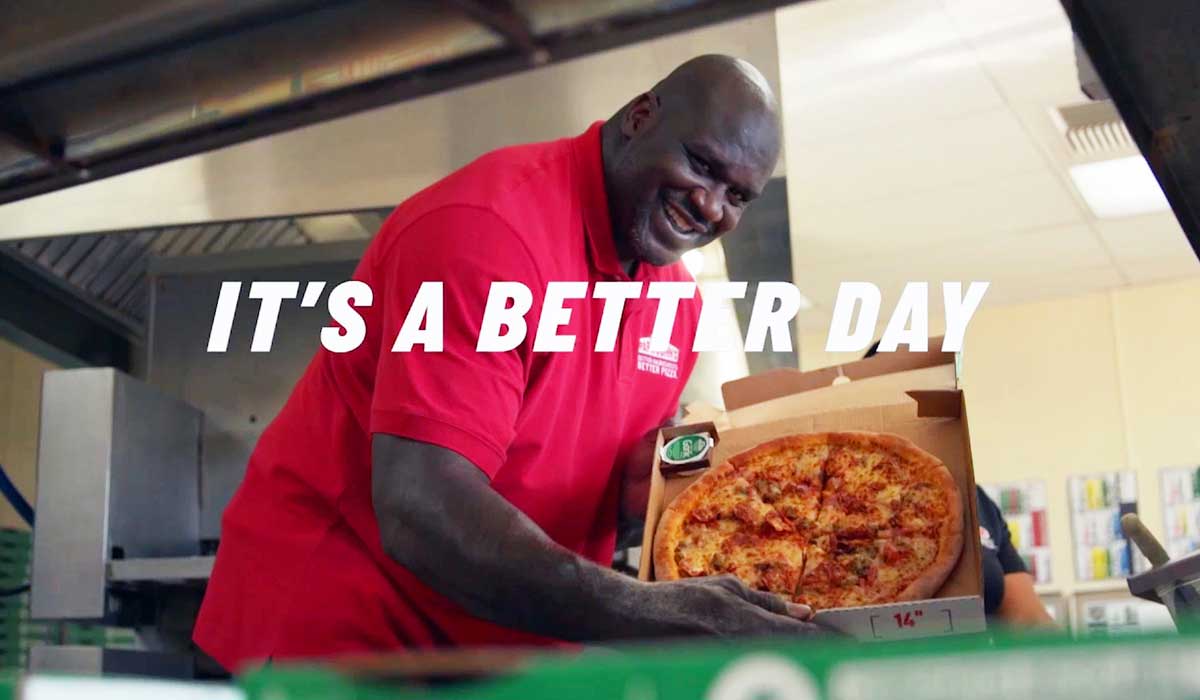
“That was his vision. That was his hope,” Papa John’s CEO Rob Lynch says of Shaquille O’Neal. “That he could come in and be a part of something that was a force for good and a force for change.”
Culture and a year like no other
“When I talk about innovation it’s not just product innovation, it’s innovation across every facet of our business up against overcoming the challenges that we faced,” Lynch says.
Really, Papa John’s brand was in chaos. Schnatter fielded heat when he criticized NFL leadership for its handling of national anthem player protests. He essentially blamed the movement for lackluster pizza sales. Within days, Papa John’s stock dipped 12 percent. It was at $90 or so in 2106 and below $50 by mid-2018. It fell further in July of that year when Schnatter reportedly used a racial slur in a conference call with marketing agency Laundry Service, who Schantter would later file suit against for extortion.
When Lynch took over as CEO from Steve Ritchie, who replaced Schnatter in January 2018, the hangover hadn’t lifted.
“I saw a brand that had a really great product proposition, a unique and distinctive place in the marketplace, and yet had fallen out of favor with a large number of customers in the industry,” he says.
In November 2019, Papa John’s revealed a streamlined senior management structure with “more clearly defined responsibilities and priorities.” This included the departure of three executives.
Papa John’s then took aim at improving the brand from within. It established Employee Resource Groups for certain interests, like the LGBTQ community. It also added Dough & Degrees, a partnership with Purdue University offering full tuition for team members’ online degree programs and added a low-cost fitness network and additional health benefits.
Marvin Boakye, chief people and diversity officer, told QSR Papa John’s instituted a new set of values and, in response, decided to participate in the Human Rights Campaign Foundation’s Corporate Equality Index for the first time. Papa Johns scored 90 percent, higher than pizza sector peers.
Papa John’s provided benefits to same-sex spouses and has covered gender reassignment surgery for several years. New initiatives included designating gender-neutral restrooms in the corporate office, adding gender identity and sexual orientation to its Equal Employment Opportunity statement, implementing transgender medical policy and procedure resource packages, and creating a gender transition workplace policy. Papa John’s also engaged in “lunch and learns” involving intersectional diversity and LGTBQ youth, included pride logos with marketing material, and participated in local pride festivals in Kentucky.
The corporate office engaged in Diversity, Equality, and Inclusion (DE&I) courses last year as well, where members faced their own biases.
Looking on the bright side of 2020, Lynch says, COVID-19 allowed Papa John’s to walk-the-walk, so to speak. Lynch joined a governing committee of a newly launched “CEO Action for Racial Equity,” fellowship in October.
“I think that mindset, being true to what we stand for and how we were going to operate as a company, helped us to eradicate some of those historical brand perception problems and frankly, come out of these situations in a whole new light,” Lynch says.

Papa John’s expects to add 200 jobs in Atlanta and continue to expand positions in both Atlanta and Louisville over the next few years.
Whitespace to gain
In September, Papa Johns signed its largest traditional store development agreement in North America in over 20 years, which promises to accelerate the brand’s presence in the Philadelphia area with HB restaurant Group—a company that owns 43 stores in the Mid-Atlantic. It plans to debut 49 new venues in Philadelphia and southern New Jersey between 2021 and 2028.
More recently, Papa John’s unveiled plans for its new headquarters in Three Ballpark Center at The Battery Atlanta. The show-stopping, 60,000-square-foot space will add 200 jobs and continue to expand positions in Atlanta and Louisville over the next few years.
Both of these moves signal runway for a brand retracting just a couple of years ago. And financial optimism skyrocketed of late. In Q2, margins in North America were the highest the company witnessed in several years as revenue jumped from $399.6 million to $460.6 million.
During COVID-19, Papa John’s worked more on infrastructure than ballooning unit count (nine North America franchisees opened in Q2, for instance), but that’s changing. “We’re building best-in-class capabilities that frankly we didn’t have before in terms of how we think about the territories both domestically as well as internationally,” Lynch said at the time. The company reported positive net unit North America growth in Q3 for the first time in three years as it opened 14 stores and closed 12.
The numbers and potential are easy to uncover. Papa John’s has about half as many restaurants as its two largest competitors domestically, and about a third internationally. They compete in nearly 100 countries while Papa John’s is in only 48.
Papa John’s actually closed 2019 as the country’s fourth-largest pizza chain.
- 1. Pizza Hut: 7,146
- 2. Domino’s: 6,157
- 3. Little Caesars: 4,213
- 4. Papa John’s: 3,142
“There’s just a huge amount of whitespace for us, and that’s what we’re going to be focused on, taking all the good stuff that we talked about, from a product standpoint, from a company standpoint, from a culture standpoint, and bringing it to more communities across the globe,” Lynch says.
There’s more to this growth story. BTIG analyst Peter Saleh believes Papa John’s balance sheet “is considerably underutilized” with leverage of 2.5x in an environment where interest rates are at, or near, historic lows.
This leverage steadily declined in recent quarters (3.4x debt/EBITDA in Q1 to 2.5x in Q3 given its sales and EBITDA progression) and should fall below 2.0x as the company enters 2021, Saleh said, placing Papa John’s several turns below its quick-service peers.
What does this mean? Saleh estimated if Papa John’s were to moderately increase its leverage to 3.5x–4.0x, it could raise as much as $300 million at those historically low interest rates. “We see no reason why Papa John’s cannot refinance its existing debt, increasing its leverage even modestly and use the proceeds to accelerate unit growth and return capital to shareholders,” Saleh said.
That under 2.0x mark would represent leverage below Dunkin’, Domino’s, Wendy’s, and Wingstop, which all operate in the 5.0–6.0x range.
While unlikely Papa John’s would increase to that level, given its higher corporate ownership mix, Saleh said, it does have plenty of room to hike.
A recent precedent: Wingstop recapitalized its balance sheet to near 6.0x leverage in October, raising $480 million through a securitized offering at an interest rate of 2.841 percent.
What this all boils down to is Papa John’s can pull levers on its own growth potential, and likely will do so.
Saleh shared a history lesson, too, which presents a compelling outlook. Schnatter’s influence and decisions throughout his reign shaped Papa John’s trajectory, naturally. One less-publicized area concerns margin structure and Papa John’s commissary segment. From April 2005 to the end of 2008, Nigel Travis served as CEO of Papa John’s and, during his tenure, commissary margins expanded from 9.1 percent in 2005 to a high of 10.9 percent in 2007. He would go on to lead Dunkin’ before retiring in July 2018.
Since, commissary margin retreated by about 380 basis points as Papa John’s fixed the margin mark-up in the mid-single digit range.
In 2019, the chain’s commissary margin was 7.1 percent, 410 basis points below its nearest competitor, Domino’s. “While we recognize that Domino’s larger domestic footprint with [about] 2,800 more locations than Papa John’s aides the segment margin, we believe Papa John’s historical handshake agreement with franchisees to fix the margin structure is antiquated and could be a source of material margin expansion in the future,” Saleh said.
If Papa John’s commissary business were to achieve an operating margin closer to its historical peak, or Domino’s current levels, Saleh said the company could generate $18.5 million of additional operating profit over each of the next two years relative to current estimates.
Saleh expects Papa John’s to more than regain all the lost sales from the past two years in 2020. That would bring the concept to sales parity with 2017. Over this time, however, system sales mix shifted to a more franchised model as Papa John’s refranchised more than 100 company units and added more than 300 net global franchises. Saleh said this should lead to higher operating margins, not lower, as he estimates operating margin to come in at 5.7 percent, or 300 basis points lower than 2017.
And there’s room to growth through menu innovation, efficient advertising, and cost reductions.
“We believe the sales gains seen this year have done wonders for franchisee economics, staving off closures and setting up the system for stronger growth next year, while management’s efforts to accelerate development, recruit new franchisees and better target geographies should begin to translate to greater openings in 2021/22,” Saleh said.

